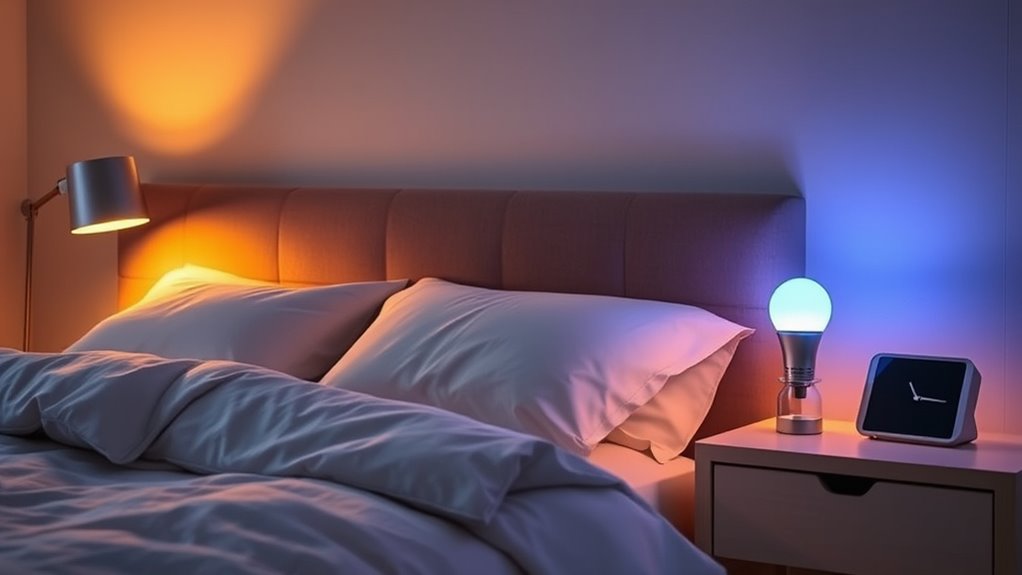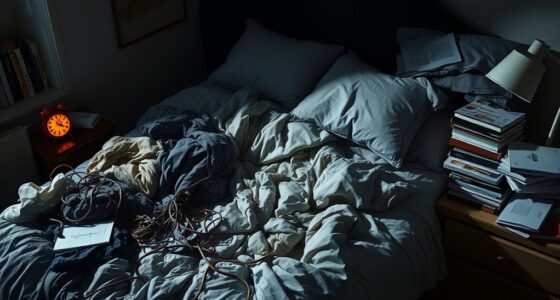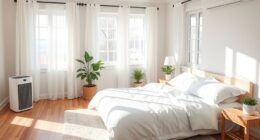Lighting markedly impacts your sleep by regulating your circadian rhythm. Exposure to bright or blue-toned light, especially at night, can suppress melatonin and make falling asleep harder. For a restful night, opt for warm, dimmable bulbs with a color temperature around 2700K-3000K, and avoid screens before bed. Using softer, indirect lighting helps your body wind down naturally. Keep exploring to discover more tips for creating the perfect sleep-friendly environment.
Key Takeaways
- Exposure to blue and bright lights at night inhibits melatonin production, disrupting sleep cycles.
- Using warm, dimmable bulbs in the evening promotes relaxation and signals the body to prepare for sleep.
- Avoiding direct glare and blue-rich lighting near bedtime helps maintain circadian rhythm integrity.
- Light color temperature (2700K-3000K) mimics sunset hues, supporting natural sleep cues.
- Installing adjustable or smart lights allows customization for a sleep-friendly environment.
How Light Affects Your Circadian Rhythm
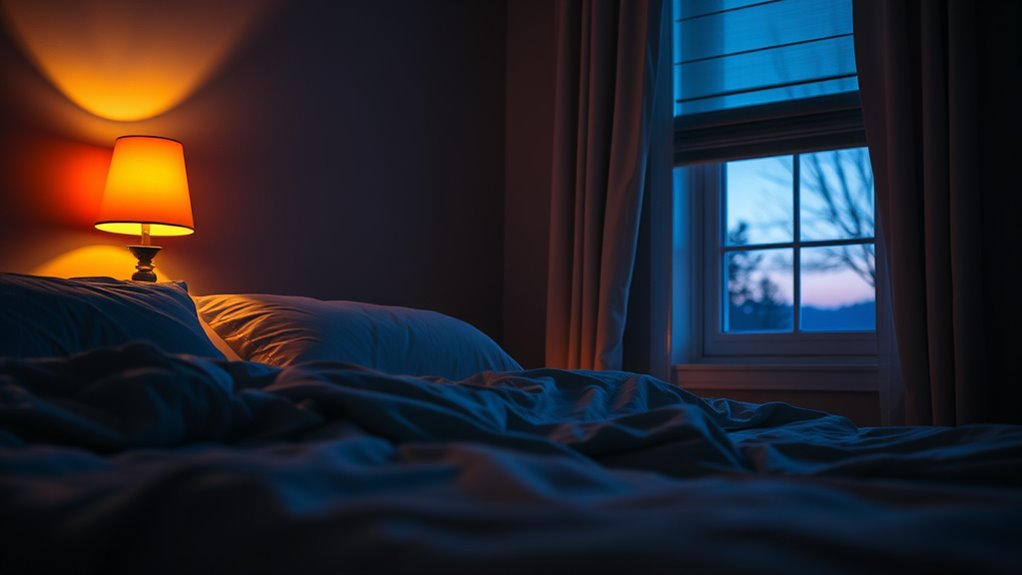
Light plays a crucial role in regulating your circadian rhythm, the internal clock that controls your sleep-wake cycle. When exposed to natural light during the day, your body promotes alertness and suppresses melatonin, helping you stay awake. However, excessive light pollution at night can disrupt this balance, leading to melatonin suppression when it should be rising. Artificial lights, especially bright or blue-toned bulbs, can interfere with your body’s natural signals, making it harder to fall asleep or wake up refreshed. By managing the light you’re exposed to during evening hours, you help keep your circadian rhythm in sync. Using appropriate lighting such as dim, warm-colored bulbs in the evening can further support your sleep cycle. Reducing light pollution and choosing appropriate lighting can markedly improve your sleep quality and overall health.
The Impact of Blue Light on Sleep Quality
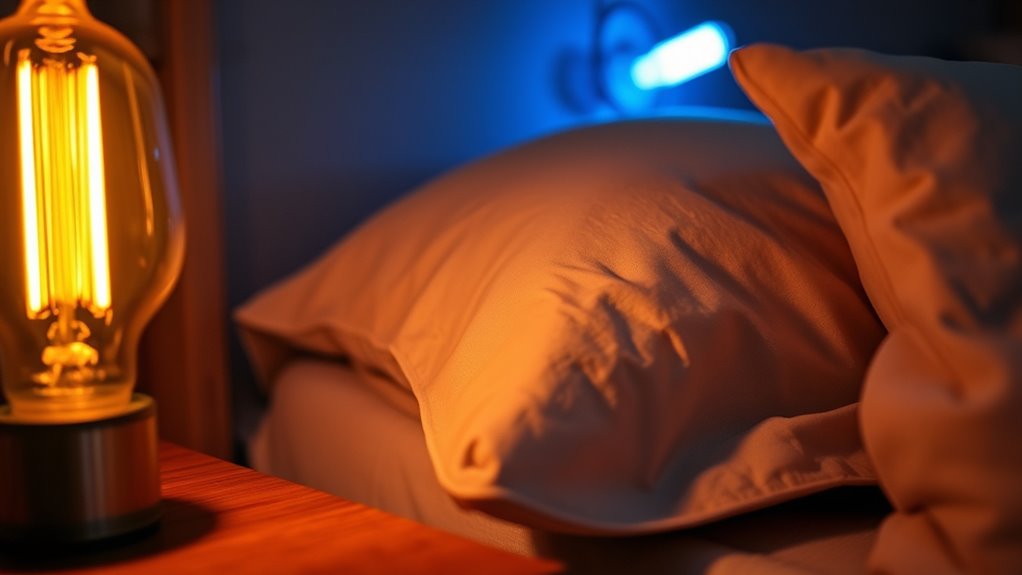
Since blue light can interfere with your body’s production of melatonin, it has a significant impact on sleep quality. Increased blue light awareness helps you understand how screens and certain LED bulbs contribute to sleep cycle disruption. When you’re exposed to blue light late at night, your body struggles to produce enough melatonin, making it harder to fall asleep and stay asleep. This disruption can lead to poorer sleep quality and daytime fatigue. Recognizing the effects of blue light enables you to take steps to minimize exposure before bedtime. Using dimmer lights or blue light filters can help protect your sleep cycle. Being mindful of blue light’s influence empowers you to create a sleep-friendly environment, improving both your sleep quality and overall well-being. Regularly monitoring your air quality and avoiding pollutants can also support healthier sleep patterns.
Choosing the Right Light Bulb for a Restful Night
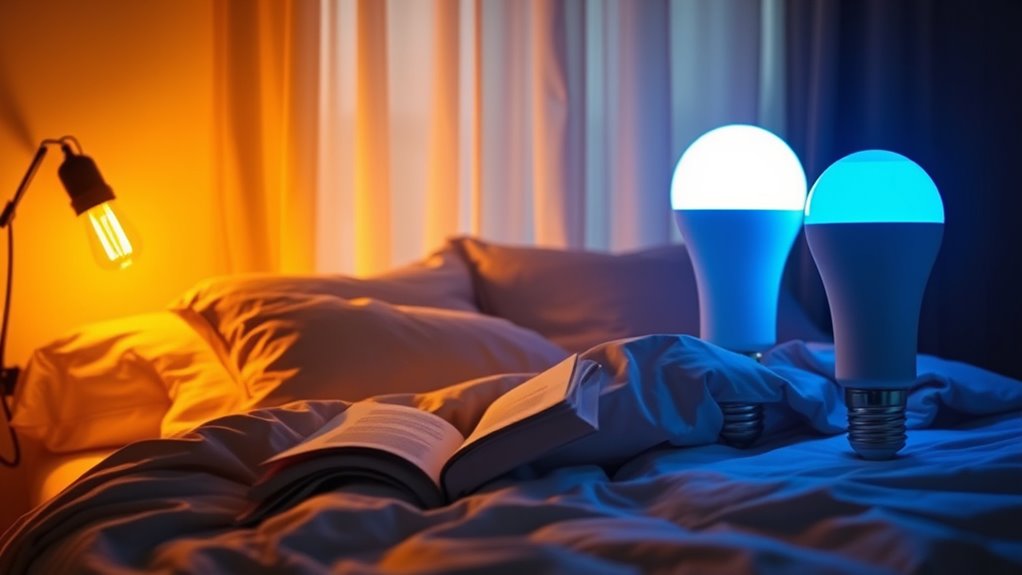
Choosing the right light bulb can make a significant difference in ensuring a restful night. Start by considering lamp placement—avoid placing lamps directly in your line of sight or near your bed to prevent glare and overstimulation. Instead, position them to provide soft, indirect lighting. Focus on selecting bulbs with a warm color temperature, around 2700K to 3000K, which mimics sunset hues and promotes relaxation. Cooler bulbs can disrupt your circadian rhythm by emitting blue-rich light, making it harder to wind down. Dimmer switches or smart bulbs let you adjust brightness and warmth, creating an ideal environment for sleep. Proper lighting choices can influence your sleep quality and overall well-being. By paying attention to lamp placement and choosing the right color temperature, you set the perfect scene for a peaceful, restorative night.
Benefits of Warm and Dimmable Lighting in the Bedroom

Warm and dimmable lighting creates an inviting atmosphere that naturally encourages relaxation before bed. By adjusting brightness and color temperature, you can enhance your mood, signaling your body that it’s time to wind down. This type of lighting helps reduce stress and promotes a calm environment, making it easier to switch into sleep. Additionally, dimmable lights contribute to energy conservation since you can lower brightness levels instead of turning on brighter, more energy-consuming bulbs. This not only supports a restful night but also saves electricity and extends bulb lifespan. Incorporating warm, adjustable lighting into your bedroom offers the dual benefits of mood enhancement and sustainable energy use, creating a perfect setting for a peaceful, restful sleep. Choosing the right light bulbs can further optimize your sleep environment and overall energy savings.
Tips for Creating a Sleep-Friendly Lighting Environment
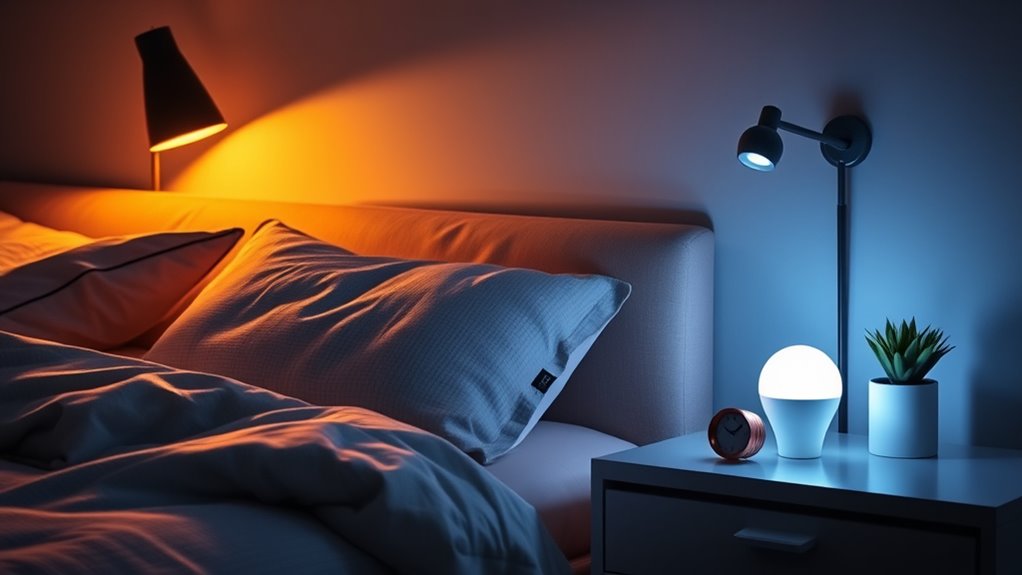
Creating a sleep-friendly lighting environment starts with controlling your light exposure in the hours before bed. Dim the lights an hour or two before bedtime to signal your body it’s time to wind down. Use warm, soft lighting to promote mood enhancement and relaxation, making it easier to fall asleep. Avoid bright, blue-rich lights that can disrupt melatonin production and delay sleep onset. Consider switching to energy-efficient bulbs with adjustable brightness, so you can tailor your lighting as needed. Limiting exposure to screens and bright lights helps conserve energy and supports your circadian rhythm. Creating a calm, low-light atmosphere not only improves sleep quality but also boosts your overall well-being. Small adjustments can make a significant difference in cultivating a restful, sleep-friendly environment. Additionally, being mindful of AI-driven safety measures in lighting technology can help reduce potential disruptions to your sleep cycle.
Frequently Asked Questions
How Does Light Exposure Before Bedtime Influence Sleep Onset?
Exposure to light before bedtime can delay your sleep onset by disrupting your circadian rhythm. Bright or blue light suppresses melatonin production, making it harder for you to fall asleep. To improve your sleep, limit screen time and dim your lights in the evening. This helps maintain your natural sleep-wake cycle and allows melatonin levels to rise, signaling your body that it’s time to rest.
Can Dim Lighting Improve Sleep Quality in Shift Workers?
Think of your circadian rhythms as a finely tuned orchestra; dim lighting can help you keep it in harmony. As a shift worker, lowering your lights before sleep can reduce melatonin suppression, making it easier to fall asleep and improve sleep quality. By mimicking natural sunset cues, you support your body’s internal clock, helping you rest better despite unconventional hours.
Are There Specific Light Wavelengths That Promote Deeper Sleep?
Certain light wavelengths, especially blue and green, can suppress melatonin and disrupt your circadian rhythm, making it harder to achieve deep sleep. To promote better sleep, you should aim to minimize exposure to these wavelengths in the evening. Instead, opt for warmer, red or amber lights, which are less likely to interfere with melatonin production and help support your natural sleep cycle for deeper, restorative sleep.
How Long Before Bedtime Should I Turn off Bright Lights?
You should turn off bright lights at least 1-2 hours before bed. Bright lights can cause serious melatonin suppression, throwing off your circadian alignment and making it nearly impossible to fall asleep. If you ignore this, you risk turning your sleep cycle into chaos, like a wild roller coaster. Dimming lights early helps your body naturally wind down, promoting better sleep and waking up refreshed. Don’t underestimate the power of darkness!
Do Sleep-Specific Light Bulbs Have Proven Health Benefits?
Sleep-specific light bulbs are designed to support your circadian rhythms by minimizing melatonin suppression. Research suggests they can improve sleep quality by providing warm, low-intensity light that doesn’t interfere with your natural sleep cycle. While they aren’t a cure-all, using these bulbs in the evening can help your body prepare for rest, making it easier to fall asleep and wake feeling refreshed.
Conclusion
By switching to the right light bulbs, you’ll unlock the secret to slipping into the most peaceful sleep of your life—like drifting into a dreamworld where darkness gently cradles you and blue light fears to disturb your rest. Imagine your bedroom transforming into a sanctuary of serenity, where every glow whispers, “Sleep now,” and your nights become so blissfully restful, you’ll wake feeling like you’ve just conquered the universe. Sweet dreams await—seize the power of perfect lighting tonight!
